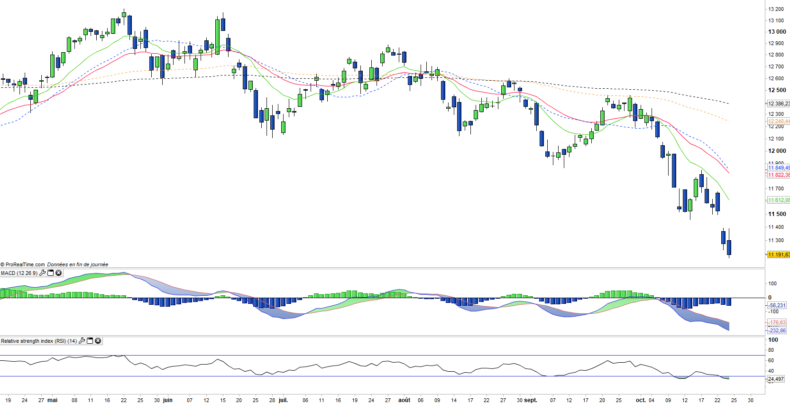Lyxor DAX - DAX - 24/10/2018
Short Term strategy: Negative (0%) / Trend -
Long Term strategy: Negative (30%) / Trend -
pour accéder à nos achats / ventes sur les indices
Characteristics of the ETF
The DAX ETF (Lyxor), quoted in Euro, replicates the DAX 30 index which is composed of the 30 largest listed German securities, representative of the main sectors of the economy, while the stocks are selected according to the importance of their market capitalization.
The costs of this ETF are low at 0.15% and AUM is quite high at 899M €, which makes it a good vehicle in terms of costs / liquidity. The replication method is direct (physical) and the dividend distribution is capitalized.
Alternative ETFS: DBXD (DB-x Tracker in Euro), DAXEX (iShares in Euro)
Index & components
The top 10 stocks are mainly large industrial stocks such as Siemens or Bayer, while there are only 3 financial stocks: Allianz, Commerzbank and Deutsche Bank, the German master index is relatively small and mostly composed of large industrial groups.
Unlike the English, French or Italian indices, the DAX is also distinguished by the absence of large oil companies that weigh heavily in the weighting of the CAC40, FTSE100 or FTSEMIB40, which is double-edged according to the cycle specific to energy sector.
In addition, the financials weigh only 16% of the index, half for the insurance giant Allianz, so the banking sector has a low weight reflected in the well-known weakness of Deutsche Bank and Commerzbank. Conversely, the automotive and chemical sectors are heavier than the other European indices, while the technology sector is mainly represented by SAP (9.9%) whose market capitalization exceeds € 100 billion.
In summary, the DAX is a fairly strong index from a sectoral point of view which can make it evolve differently from other European indices. German fundamentals are very solid (GDP growth above 2%, historically low unemployment rate at 5.5% and accelerated deleveraging up to 2020). The main risks concern Germany's main customers, namely the United Kingdom, which could suffer from Brexit, the US in political uncertainty and threatening it with a trade war, Russia which remains a difficult and aggressive neighbor and China because of its commercial practices which also tend to limit access to its domestic market to Western industrialists, particularly in the automotive and technology sectors.
Latest developments
After an increase of 6.9% in 2016, the DAX30 grew by 12.5% in 2017, more than the stoxx600 (+ 10.6%). But the index has now fallen by 12.7% since the beginning of the year, which is a lower performance than the Stoxx600NR (-6.7%).
This underperformance is linked to the cyclical profile of the DAX, which is mainly composed of cyclical stocks and underweight in health and energy stocks, which is to put into perspective the fear of a slowdown in global GDP growth.
This fear is fueled by disappointing business results so far with many profit warnings, and investment lags. The anxiety environment created by D.Trump is beginning to affect economic actors.
Weekly data
On the weekly chart, we can see an head & shoulders pattern that has been validated and gives a theoretical target at 10,500 pts which leaves a residual potential of decline of about 6%. However the index just touched the EMA200 and a break on these levels is possible. The medium-term trend is bearish and comparable to the big correction of 2016, there is currently no sign of slowing down in this downward movement that seems less impulsive but perhaps more sustainable.
Daily data
The daily chart shows a situation of bearish acceleration with a gap open to the downside that allows to cross clearly now the medium-term support area. The index is now in free fall and should move quickly towards the goal of the head & shoulder towards 10500 pts. A rapid filling of the gap is unlikely, but a test of a few days is possible before a relapse.
ETF objective
DAX is a UCITS ETF, listed in EUR, which seeks to replicate the German DAX index (30 companies)
Characteristics
| Inception date | 01/06/2006 |
| Expense ratio | 0,15% |
| Issuer | Lyxor |
| Benchmark | Indice DAX 30 |
| Code/Ticker | DAX |
| ISIN | LU0252633754 |
| UCITS | Yes |
| Currency | € |
| Exchange | Euronext |
| Assets Under Management | 897 M€ |
| Replication Method | Direct (Physical) |
| PEA (France) | Yes |
| SRD (France) | Yes |
| Dividend | Capitalization |
| Currency risk | No |
| Number of Holdings | 30 |
| Risk | 3/5 |
Country Breakdown
| Germany | 100% |
Sector Breakdown
| Consumer discretionary | 16% |
| Financials | 16% |
| Materials | 14% |
| Industrials | 14% |
| Health Care | 14% |
| Information Technology | 13% |
| Communication Services | 5% |
| Autres | 9% |
Top Ten Holdings
| SAP | 10% |
| Siemens | 9% |
| Allianz | 9% |
| Bayer | 8% |
| BASF | 7% |
| Daimler | 5% |
| Deutsche Telekom | 5% |
| Adidas | 4% |
| Linde | 4% |
| Muenchener Rueckver | 3% |


